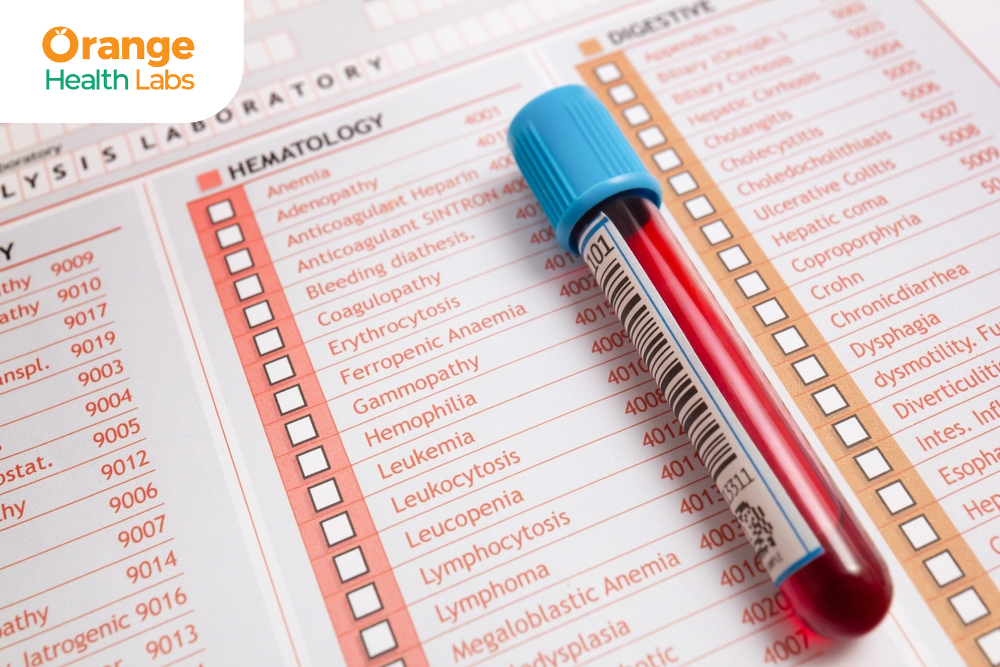Search for tests or checkups
SupportEarly Signs of Typhoid Fever: When to Get a Widal Test?
Typhoid fever is a severe bacterial infection that can affect multiple organs. It spreads through contaminated food and water, leading to severe health issues if not diagnosed and treated quickly. Widal test, a widely accessible diagnostic tool, can help detect typhoid fever.
Understanding Typhoid Fever
Typhoid fever, also known as enteric fever, is caused by the bacteria Salmonella typhi (S. typhi) and primarily affects the small intestines. The typhoid bacteria spread through contaminated water and can be present in the faeces of infected individuals. Not washing your hands after using the toilet can spread the bacteria to food and spread the disease. In regions with poor sanitation, bacteria in human waste can contaminate the water supply, increasing the risk of widespread typhoid fever.
Early Signs and Symptoms of Typhoid Fever
Early signs and symptoms of typhoid fever generally appear 1 to 2 weeks after exposure and include:
- High Fever: A prolonged and gradually increasing fever accompanied by chills and body aches is one of the most common typhoid symptoms.
- Headaches: Persistent headaches accompanied by fever and cough.
- Abdominal Pain: Discomfort or pain in the abdominal area accompanied by diarrhoea or constipation.
- Fatigue: Feeling worn out, tired, and weak.
- Loss of Appetite: A reduced desire to eat accompanied by nausea.
As typhoid symptoms gradually worsen, you may also experience:
- Rashes on the abdomen or stomach known as rose spots.
- Agitation, confusion, or delirium, including hallucinations (imagining things that aren’t there).
- Difficulty concentrating and attention deficit.
- Nosebleeds and blood in stools.
- A slow, sluggish, weak feeling with severe fatigue.
If untreated, typhoid can worsen over weeks and lead to severe, life-threatening complications such as bleeding and perforation in the digestive tract, spreading the infection to nearby tissues. Recovery may take weeks to months, and symptoms may recur. For the timely detection of typhoid from the comfort of your home, you can schedule the Widal Test (Slide Method) at home.
When Is the Right Time to Get a Widal Test?
Knowing when to get the Widal Test is crucial for early diagnosis and effective typhoid treatment. Here are some situations where you should consider getting tested:
- Persistent Symptoms: If you experience symptoms of typhoid, such as prolonged fever, abdominal pain, fatigue, or other symptoms associated with typhoid fever that do not improve over time, it is essential to seek medical advice. A Widal test can help check whether the symptoms are caused by typhoid.
- Recent Travel: If you have recently travelled to regions where typhoid is prevalent and are experiencing symptoms, it makes typhoid fever more likely and getting a Widal test is advisable.
- Exposure to Contamination: If you have had potential exposure to contaminated food or water or if you have been in contact with someone with typhoid, you should get a Widal test to determine whether you have typhoid fever.
- Follow Up on Previous Results: If you previously had a negative Widal test but your symptoms persist, it is advisable to get the Widal test again.
- Recurring Symptoms: If you have previously had typhoid and your symptoms return, particularly with new symptoms like nosebleeds, confusion, or blood in stools, a Widal test can help determine if the infection has recurred.
How Does the Widal Test Work?
The Widal test is a diagnostic blood test used to detect typhoid fever by measuring specific antibodies against Salmonella typhi. When an individual is infected with typhoid, the immune system produces antibodies to fight the infection. The Widal test can identify antibodies for two key antigens (antigens O and H) located on the surface of the bacteria to check if you have a current or recent infection. It can be done by two methods:
- Slide Test: This is a quick screening test where a drop of the patient’s serum is mixed with a drop of antigen solution on a slide. Clumping in this mixture indicates a positive result, suggesting an active or recent infection.
- Tube Test: This test provides a more detailed report and is done when the slide test is positive.
The Widal Test (Slide Method) cost is generally affordable and the test is widely available.
Check Widal Test Cost in Your City: Widal test price in Bangalore | Widal Test in Delhi | Widal test price in Hyderabad | Widal test price in Gurgaon | Widal test price in Mumbai | Widal test price in Noida
Preventive Measures
Alongside getting tested for typhoid with the Widal Test (Slide Method) at home, incorporating simple practices such as drinking safe water, avoiding contaminated food, and maintaining proper hand hygiene will significantly reduce the risk of typhoid fever. In high-risk areas, regular testing, and preventive measures, including vaccinations, are essential to lower the chances of infection.
Conclusion
Typhoid is a disease that requires timely diagnosis and treatment to prevent complications and worsening of the condition. Identifying the early signs of typhoid by getting the Widal Test (Slide Method) in Bangalore is your first step toward getting the treatment you need. The early detection of typhoid through this simple and effective test can lead to better outcomes and a faster recovery.

What Are Skin Allergy Types, Symptoms and Causes

The Importance of Early HIV Detection: A Medical Perspective
